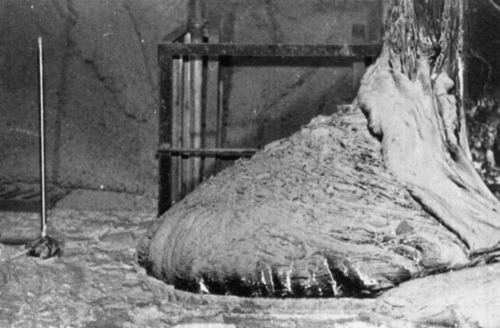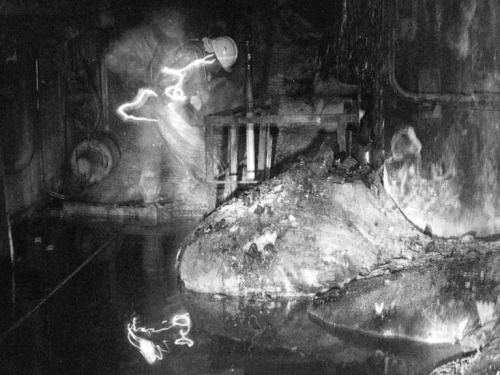Stubborn-turtle-blog

More Posts from Stubborn-turtle-blog and Others



After the devastating earthquake in Amatrice, Italy, on August 24th, the Vigili del Fuoco (Italian fire brigade) requested assistance from the TRADR (Long-Term Human-Robot Teaming for Robot-Assisted Disaster Response) project (EU FP7 framework, grant No. 60963). TRADR deployed two Unmanned Ground Vehicles (UGVs) and three Unmanned Aerial Vehicles (UAVs) to assist the post-earthquake response in Amatrice.
The task was to use robots to provide 3D textured models of two churches, San Francesco and Sant’ Agostino, national heritage monuments from the XIVth century. Both were in a state of partial collapse and in need of shoring to prevent potential further destruction. The models should serve to plan the shoring operations and to assess the state of various objects of cultural value inside the churches, such as valuable frescos.
The UGVs successfully entered the San Francesco church, teleoperated entirely out of line of sight and partially in collaboration. For part of the mission, one UGV provided a view of the other one to enable maneuvering in very constrained space with low connection bandwidth. One of the UGVs operated in the church continuously for four hours. A UAV was also present for a short time in parallel and provided additional views of the UGVs.
This would have been so empowering for my ALS-stricken grandfather

Obi was built by Jon and Tom Dekar, the father-son duo that founded Obi parent company DESῙN in 2010. They spent the next six years refining Obi’s design, securing investors, sourcing suppliers, and testing prototypes. The first Obi prototype was designed in 2006 by Jon, a University of Dayton engineering student, who saw the challenges faced by people with disabilities as varied as his aging grandfather and a 6-year-old girl with Arthrogryposis.
“Every day, millions of people must be fed by caregivers, and they find the experience to be conspicuous and frustrating,” Jon said. “Feeding oneself is a basic human need, and there was no good solution available. I became inspired to change that.”
International tango is also the middle of a fight

“The forms of tango are like stages of a marriage. The American tango is like the beginning of a love affair, when you’re both very romantic and on your best behavior. The Argentine tango is when you’re in the heat of things and all kinds of emotions are flying: passion, anger, humor. The International tango is like the end of the marriage, when you’re staying together for the sake of the children.” -Barbara Garvey

IS SCIENCE EATING ITS YOUNG?
Background. Scientists and policy makers around the world increasingly worry about the plight of young researchers in academia, and for good reason. Competition for tenure-track positions has surged, and some early career researchers face tough odds in the quest for funding. This week Nature pleads the case for the young in a special issue.
Design challenge. How do we visually convey the idea that science is eating its young? We felt it was important to represent a system that has gone wrong, with various consequences, in an engaging way. The metaphor of a video came to mind, as young scientists find themselves trapped in framework, playing along.
We gave this brief to Megapont, an artist that specializes in isometric pixel art, and he created a fantastic scene for the cover. The retro gaming vibe gives a sense of an aging system that needs an overhaul. The detail in the artwork rewards the observant reader, with hidden treasures and references to iconic games and other worlds. And check out the tiny rat fleeing the scene - only a few pixels!
Have your say. Perhaps you are a young scientist who identifies with a cover character? Maybe the one slouched in dispair on the floor, or the one cutting out in bunny slippers? We’d like to hear your story – here’s a tumblr just for you: researchrealities.tumblr.com
-Kelly Krause
More Than Just Drawings
Artist and graphic designer Mike Okuda may not be a household name, but you’re more familiar with his work than you know. Okuda’s artistic vision has left a mark here at NASA and on Star Trek. The series debuted 50 years ago in September 1966 and the distinctive lines and shapes of logos and ships that he created have etched their way into the minds of fans and inspired many.
Flight Ops

The Flight Operations patch has a lengthy history, the original version of which dates to the early 1970s. Having designed a version of the patch, Okuda had some insights about the evolution of the design.
“The original version of that emblem was designed around 1972 by Robert McCall and represented Mission Control. It later changed to Mission Operations. I did the 2004 version, incorporating the space station, and reflecting the long-term goals of returning to the Moon, then on to Mars and beyond. I later did a version intended to reflect the new generation of spacecraft that are succeeding the shuttle, and most recently the 2014 version reflecting the merger of Mission Operations with the Astronaut Office under the new banner Flight Operations.”
“The NASA logos and patches are an important part of NASA culture,” Okuda said. “They create a team identity and they focus pride on a mission.”

In July 2009, Okuda received the NASA Exceptional Public Service Medal, which is awarded to those who are not government employees, but have made exceptional contributions to NASA’s mission. Above, Okuda holds one of the mission patches he designed, this one for STS-125, the final servicing mission to the Hubble Space Telescope.
Orion

Among the other patches that Okuda has designed for us, it one for the Orion crew exploration vehicle. Orion is an integral of our Journey to Mars and is an advanced spacecraft that will take our astronauts deeper into the solar system than ever before.
Okuda’s vision of space can be seen in the Star Trek series through his futuristic set designs, a vision that came from his childhood fascination with the space program.
Learn more about Star Trek and NASA.
Make sure to follow us on Tumblr for your regular dose of space: http://nasa.tumblr.com

Some guy just mansplained space to an actual fucking astronaut.
Where is this, and what’s up with the white-washed parts of the towers?

Spring Mornings // Johannes Hoehn



Edgley Design builds family home around 100-year-old pear tree in south London »


One of the most dangerous pictures ever taken - Elephant’s Foot, Chernobyl. This is a photo of a now dead man next the ‘Elephant’ Foot’ at the Chernobyl power plant.
The image distortions in the photo are created by intense level of radiation almost beyond comprehension. There is no way the person in this photo and the person photographing him could have survived for any more that a few years after being there, even if they quickly ran in, took the photos and ran out again. This photo would be impossible to take today as the rates of radioactive decay are even more extreme now due to a failed military experiment to bomb the reactor core with neuron absorbers. The foot is made up of a small percentage of uranium with the bulk mostly melted sand, concrete and other materials which the molten corium turns into a kind of lava flow. In recent years, it has destroyed a robot which tried to approach it, and the last photos were taken via a mirror mounted to a pole held at the other end of the corridor for a few seconds. It is almost certainly the most dangerous and unstable creation made by humans. These are the effects of exposure: 30 seconds of exposure - dizziness and fatigue a week later 2 minutes of exposure - cells begin to hemorrhage (ruptured blood vessels) 4 minutes - vomiting, diarrhea, and fever 300 seconds - two days to live
-
 sushimotto reblogged this · 8 years ago
sushimotto reblogged this · 8 years ago -
 nymphxmxniac liked this · 8 years ago
nymphxmxniac liked this · 8 years ago -
 milk-and-meat liked this · 8 years ago
milk-and-meat liked this · 8 years ago -
 njmazaa-blog liked this · 8 years ago
njmazaa-blog liked this · 8 years ago -
 darkelf19 reblogged this · 8 years ago
darkelf19 reblogged this · 8 years ago -
 whenthecrowcalls reblogged this · 8 years ago
whenthecrowcalls reblogged this · 8 years ago -
 etherealbeau-ty reblogged this · 8 years ago
etherealbeau-ty reblogged this · 8 years ago -
 guccimangoes reblogged this · 8 years ago
guccimangoes reblogged this · 8 years ago -
 guccimangoes liked this · 8 years ago
guccimangoes liked this · 8 years ago -
 chuckysoulchild reblogged this · 8 years ago
chuckysoulchild reblogged this · 8 years ago -
 chuckysoulchild liked this · 8 years ago
chuckysoulchild liked this · 8 years ago -
 blaqueronin623 liked this · 8 years ago
blaqueronin623 liked this · 8 years ago -
 a2tunes liked this · 8 years ago
a2tunes liked this · 8 years ago -
 scrming liked this · 8 years ago
scrming liked this · 8 years ago -
 saxystephanie reblogged this · 8 years ago
saxystephanie reblogged this · 8 years ago -
 uneducatedhendrix-blog liked this · 8 years ago
uneducatedhendrix-blog liked this · 8 years ago -
 intriguedyet liked this · 8 years ago
intriguedyet liked this · 8 years ago -
 tediumterrordesign liked this · 8 years ago
tediumterrordesign liked this · 8 years ago -
 thesunand-themoon-blog liked this · 8 years ago
thesunand-themoon-blog liked this · 8 years ago -
 nightsparks77 reblogged this · 8 years ago
nightsparks77 reblogged this · 8 years ago -
 realm-of-fandom liked this · 8 years ago
realm-of-fandom liked this · 8 years ago -
 regaliajack-blog liked this · 8 years ago
regaliajack-blog liked this · 8 years ago -
 yourboystookahellofabeating reblogged this · 8 years ago
yourboystookahellofabeating reblogged this · 8 years ago -
 yourboystookahellofabeating liked this · 8 years ago
yourboystookahellofabeating liked this · 8 years ago -
 spacemetal-cloudmountain reblogged this · 8 years ago
spacemetal-cloudmountain reblogged this · 8 years ago -
 kripd reblogged this · 8 years ago
kripd reblogged this · 8 years ago -
 malus-canis reblogged this · 8 years ago
malus-canis reblogged this · 8 years ago -
 ohwhat-thehell reblogged this · 8 years ago
ohwhat-thehell reblogged this · 8 years ago -
 moonlight-jesss reblogged this · 8 years ago
moonlight-jesss reblogged this · 8 years ago -
 from-lily reblogged this · 8 years ago
from-lily reblogged this · 8 years ago -
 wastedallninelives reblogged this · 8 years ago
wastedallninelives reblogged this · 8 years ago -
 wastedallninelives liked this · 8 years ago
wastedallninelives liked this · 8 years ago -
 so-this-is-my-blog-i-guess liked this · 8 years ago
so-this-is-my-blog-i-guess liked this · 8 years ago -
 mrmofosfuckinsafetyfirstblog reblogged this · 8 years ago
mrmofosfuckinsafetyfirstblog reblogged this · 8 years ago -
 mrmofosfuckinsafetyfirstblog liked this · 8 years ago
mrmofosfuckinsafetyfirstblog liked this · 8 years ago -
 mindisdeception-blog reblogged this · 8 years ago
mindisdeception-blog reblogged this · 8 years ago -
 spacesapphicc liked this · 8 years ago
spacesapphicc liked this · 8 years ago -
 belkjudith liked this · 8 years ago
belkjudith liked this · 8 years ago -
 fiestabear liked this · 8 years ago
fiestabear liked this · 8 years ago -
 heather-kasuga reblogged this · 8 years ago
heather-kasuga reblogged this · 8 years ago -
 gay-treasure liked this · 8 years ago
gay-treasure liked this · 8 years ago
Gaming, Science, History, Feminism, and all other manners of geekery. Also a lot of dance
243 posts